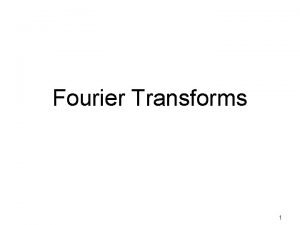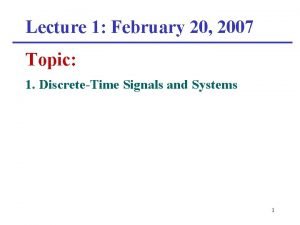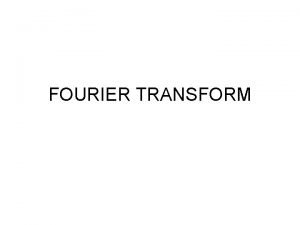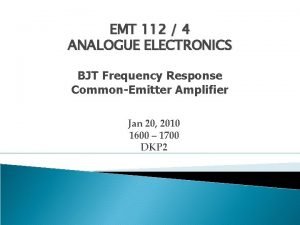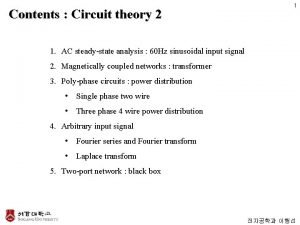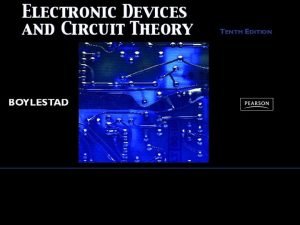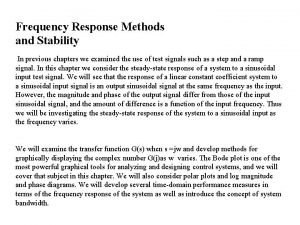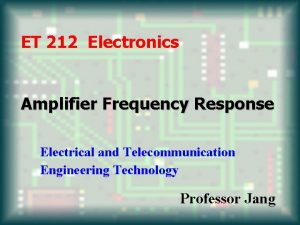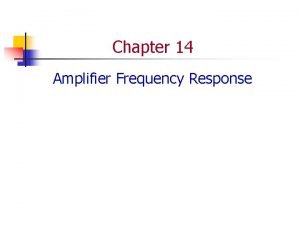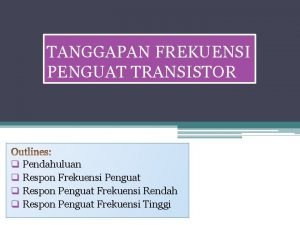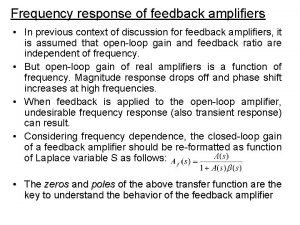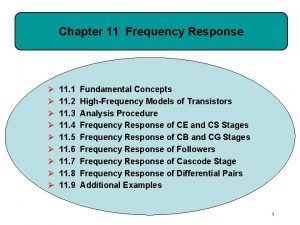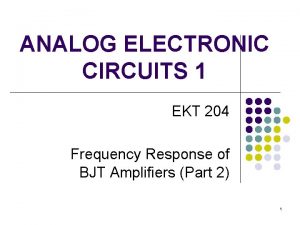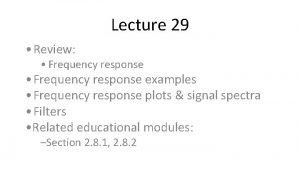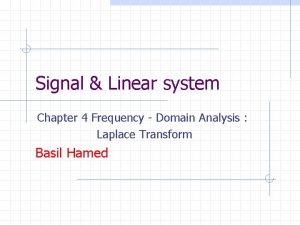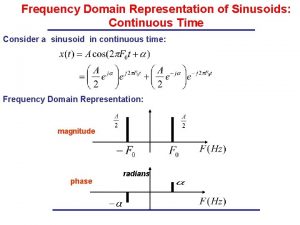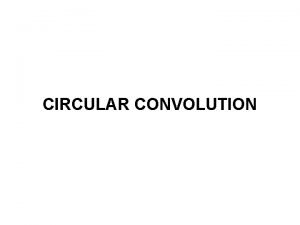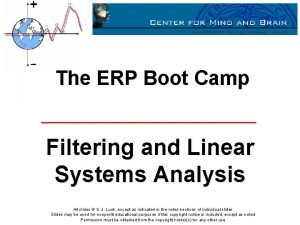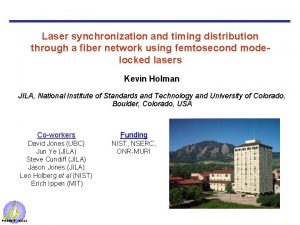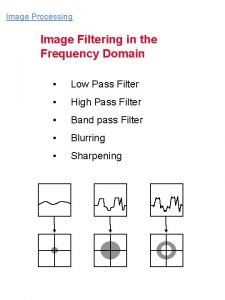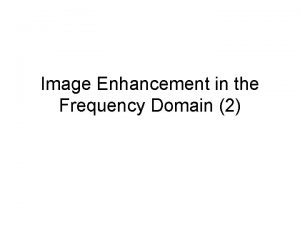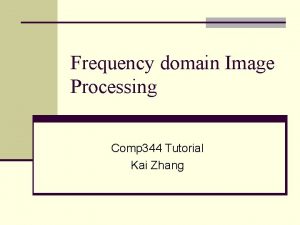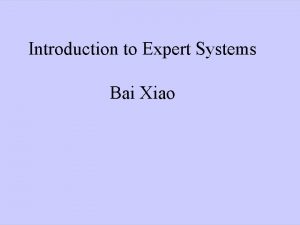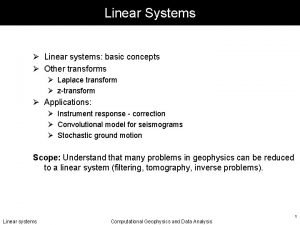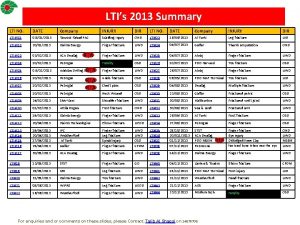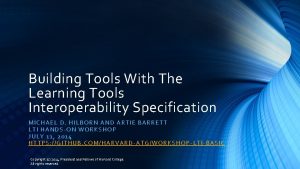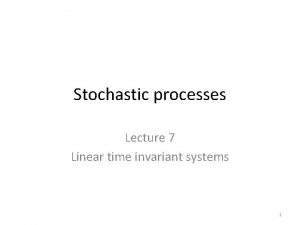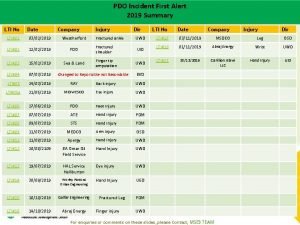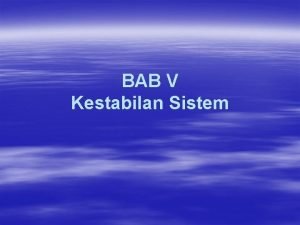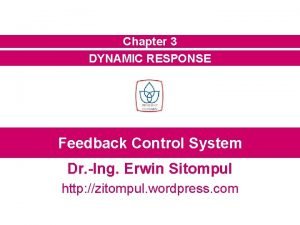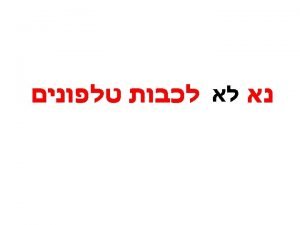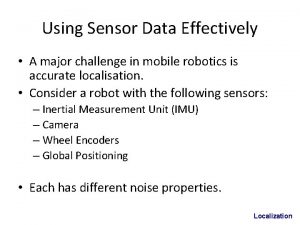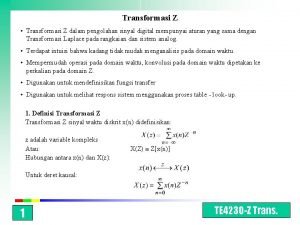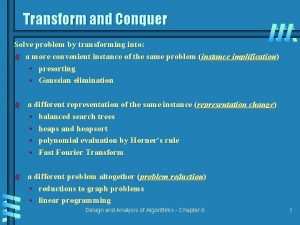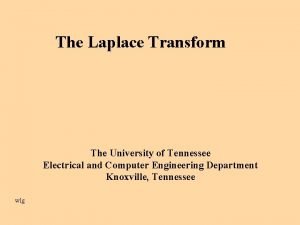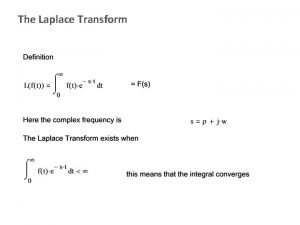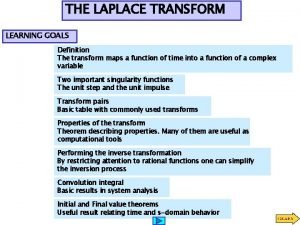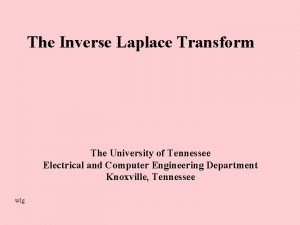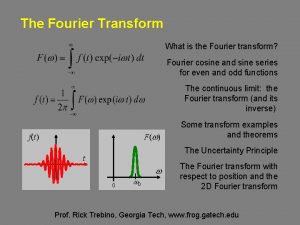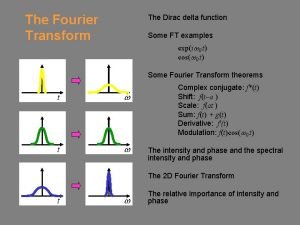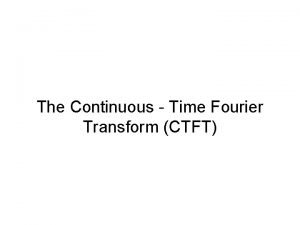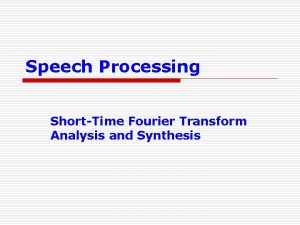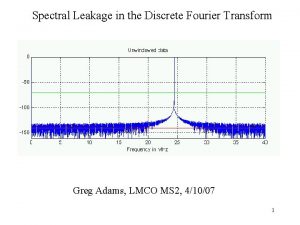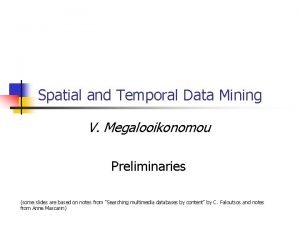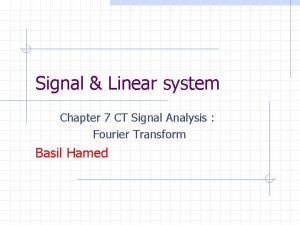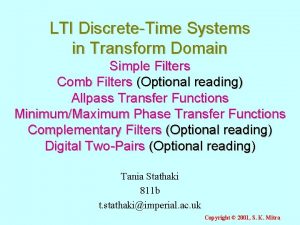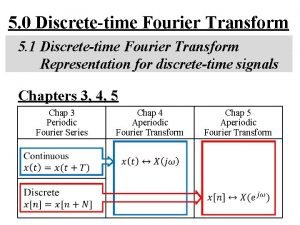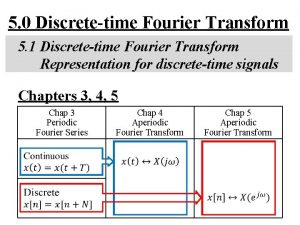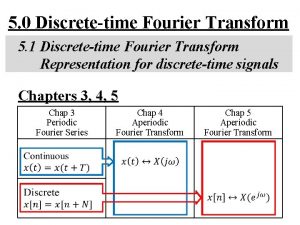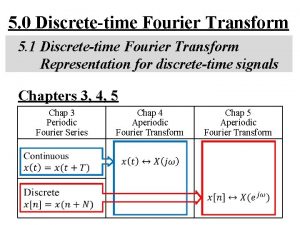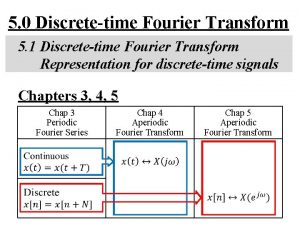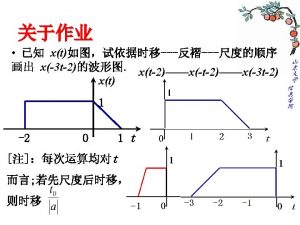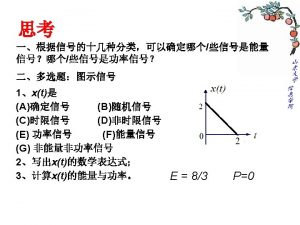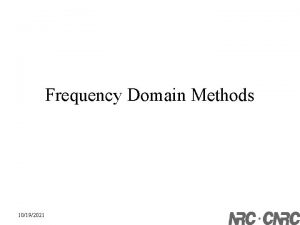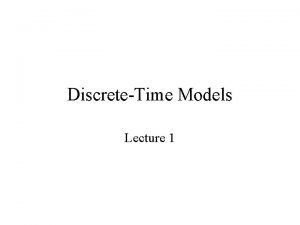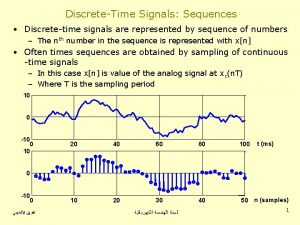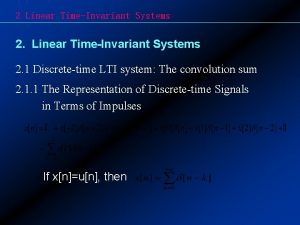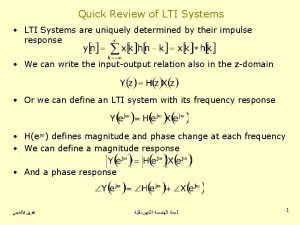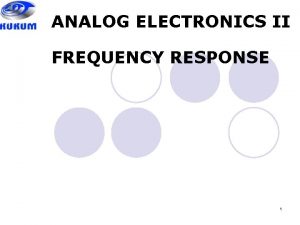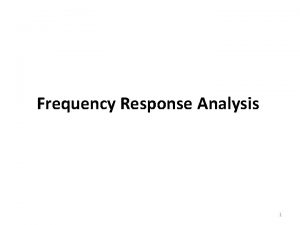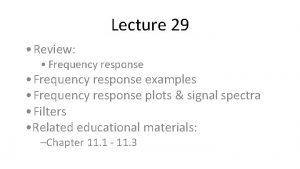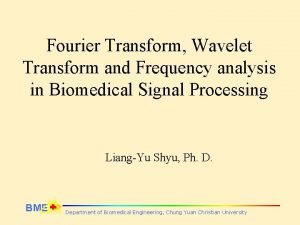LTI DiscreteTime Systems in Transform Domain Frequency Response



















![Example 2 – Steady-State Response • Determine the steady-state output y[n] of a real Example 2 – Steady-State Response • Determine the steady-state output y[n] of a real](https://slidetodoc.com/presentation_image_h2/adcd9b068afca16014d8b5cdee3da2e5/image-20.jpg)
![Example 2 – Steady State Response • We can express the input x[n] as Example 2 – Steady State Response • We can express the input x[n] as](https://slidetodoc.com/presentation_image_h2/adcd9b068afca16014d8b5cdee3da2e5/image-21.jpg)
![Example 2 – Steady State Response • Because of linearity, the response v[n] to Example 2 – Steady State Response • Because of linearity, the response v[n] to](https://slidetodoc.com/presentation_image_h2/adcd9b068afca16014d8b5cdee3da2e5/image-22.jpg)

![Example 2 – Steady State Response • Thus, the output y[n] has the same Example 2 – Steady State Response • Thus, the output y[n] has the same](https://slidetodoc.com/presentation_image_h2/adcd9b068afca16014d8b5cdee3da2e5/image-24.jpg)

















![The Transfer Function - Stability • Therefore, the impulse response h[n] is of infinite The Transfer Function - Stability • Therefore, the impulse response h[n] is of infinite](https://slidetodoc.com/presentation_image_h2/adcd9b068afca16014d8b5cdee3da2e5/image-42.jpg)



![Example 4 – Effects of Quantization h[n] 46 • As can be seen from Example 4 – Effects of Quantization h[n] 46 • As can be seen from](https://slidetodoc.com/presentation_image_h2/adcd9b068afca16014d8b5cdee3da2e5/image-46.jpg)
![Example 4 – Effects of Quantization • The absolute summability condition of h[n] is Example 4 – Effects of Quantization • The absolute summability condition of h[n] is](https://slidetodoc.com/presentation_image_h2/adcd9b068afca16014d8b5cdee3da2e5/image-47.jpg)



































![Phase and Group Delays • The output y[n] of a frequency-selective LTI discrete-time system Phase and Group Delays • The output y[n] of a frequency-selective LTI discrete-time system](https://slidetodoc.com/presentation_image_h2/adcd9b068afca16014d8b5cdee3da2e5/image-83.jpg)





![Phase and Group Delays • The output y[n] is then given by • Note: Phase and Group Delays • The output y[n] is then given by • Note:](https://slidetodoc.com/presentation_image_h2/adcd9b068afca16014d8b5cdee3da2e5/image-89.jpg)











- Slides: 100

LTI Discrete-Time Systems in Transform Domain Frequency Response Transfer Function Introduction to Filters Tania Stathaki 811 b t. stathaki@imperial. ac. uk 1

Frequency Response of an LTI Discrete-Time System • The well known convolution sum description of an LTI discrete-time system is given by • Taking the DTFT of both sides we obtain 2

Frequency Response of an LTI Discrete-Time System • Or, 3

Frequency Response of an LTI Discrete-Time System • Hence, we can write • The above equation relates the input and the output of an LTI system in the frequency domain • It follows that 4

Frequency Response of an LTI Discrete-Time System • The function is called the frequency response of the LTI discrete-time system • provides a frequency-domain description of the system • is precisely the DTFT of the impulse response {h[n]} of the system 5

Frequency Response of an LTI Discrete-Time System • , in general, is a complex function of w with a period 2 p • It can be expressed in terms of its real and imaginary part or, in terms of its magnitude and phase, where 6

Frequency Response of an LTI Discrete-Time System • Note: Magnitude and phase functions are real functions of w, whereas the frequency response is a complex function of w • If the impulse response h[n] is real then it is proven that the magnitude function is an even function of w: and the phase function is an odd function of w: • Likewise, for a real impulse response h[n], is odd 7 is even and

Magnitude and Phase Response • The function is called the magnitude response and the function is called the phase response of an LTI discrete-time system • Design specifications for an LTI discretetime system, in many applications, are given in terms of the magnitude response or the phase response or both 8

Gain Function Attenuation/Loss Function • In some cases, the magnitude function is specified in decibels as where is called the gain function • The negative of the gain function is called the attenuation or loss function 9

Eigenfunction of a System • If the input of an LTI system is a single complex exponential function then it follows that the output is given by • Let 10

Eigenfunction of a System • Therefore, we can write • Thus for a complex exponential input signal , the output of an LTI discrete-time system is also a complex exponential signal of the same frequency multiplied by a complex constant • is called eigenfunction of the system 11

Frequency Response of a System Described by a Difference Equation • Consider an LTI discrete-time system characterized by a difference equation • Its frequency response is obtained by taking the DTFT of both sides of the above equation 12

Example 1 – Frequency Response of a Moving Average (MA) Filter • Consider the M-point moving average filter with an impulse response given by • Its frequency response is then given by 13

Example 1 - Moving Average Filter • Or, 14

Example 1 - Moving Average Filter • Thus, the magnitude response of the Mpoint moving average filter is given by and the phase response is given by 15

Example 1 - Moving Average Filter Frequency Response Computation Using MATLAB • The function freqz(h, w) can be used to determine the values of the frequency response vector h at a set of given frequency points w • From h, the real and imaginary parts can be computed using the functions real and imag, and the magnitude and phase functions using the functions abs and angle 16

Example 1 - Moving Average Filter Frequency Response Computation Using MATLAB • The magnitude and phase responses of an M-point moving average filter are shown below • The jumps in the phase function occur at the zeros of the frequency response, where the sinc function changes sign. 17

Example 1 - Moving Average Filter Frequency Response Computation Using MATLAB • The phase response of a discrete-time system when determined by a computer may exhibit jumps by an amount 2 p caused by the way the arctangent function is computed • The phase response can be made a continuous function of w by “unwrapping” the phase response across the jumps 18

Example 1 - Moving Average Filter Frequency Response Computation Using MATLAB • To this end the function unwrap can be used, provided the computed phase is in radians • The jumps by the amount of 2 p should not be confused with the jumps caused by the zeros of the frequency response as indicated in the phase response of the moving average filter 19
![Example 2 SteadyState Response Determine the steadystate output yn of a real Example 2 – Steady-State Response • Determine the steady-state output y[n] of a real](https://slidetodoc.com/presentation_image_h2/adcd9b068afca16014d8b5cdee3da2e5/image-20.jpg)
Example 2 – Steady-State Response • Determine the steady-state output y[n] of a real coefficient LTI discrete-time system with a frequency response for an input • Note that the frequency response determines the steady-state response of an LTI discrete-time system to a sinusoidal input 20
![Example 2 Steady State Response We can express the input xn as Example 2 – Steady State Response • We can express the input x[n] as](https://slidetodoc.com/presentation_image_h2/adcd9b068afca16014d8b5cdee3da2e5/image-21.jpg)
Example 2 – Steady State Response • We can express the input x[n] as where • Now the output of the system for an input is simply 21
![Example 2 Steady State Response Because of linearity the response vn to Example 2 – Steady State Response • Because of linearity, the response v[n] to](https://slidetodoc.com/presentation_image_h2/adcd9b068afca16014d8b5cdee3da2e5/image-22.jpg)
Example 2 – Steady State Response • Because of linearity, the response v[n] to an input g[n] is given by • Likewise, the output v*[n] to the input g*[n] is 22

Example 2 – Steady State Response • Combining the last two equations we get 23
![Example 2 Steady State Response Thus the output yn has the same Example 2 – Steady State Response • Thus, the output y[n] has the same](https://slidetodoc.com/presentation_image_h2/adcd9b068afca16014d8b5cdee3da2e5/image-24.jpg)
Example 2 – Steady State Response • Thus, the output y[n] has the same sinusoidal waveform as the input with two differences: (1) the amplitude is multiplied by , the value of the magnitude function at (2) the output has a phase lag relative to the input by an amount , the value of the phase function at 24

Example 3 – Response to a Causal Exponential Sequence • The expression for the steady-state response developed earlier assumes that the system is initially relaxed before the application of the input • In practice, excitation (input) to a discretetime system is usually a right-sided sequence applied at some sample index • We develop the expression for the output for such an input 25

Example 3 – Response to a Causal Exponential Sequence • Without any loss of generality, assume for n < 0 • From the input-output relation we observe that for an input the output is given by 26

Example 3 – Response to a Causal Exponential Sequence • Or, • The output for n < 0 is y[n] = 0 • The output for is given by 27

Example 3 – Response to a Causal Exponential Sequence • Or, • The first term on the RHS is the same as that obtained when the input is applied at n = 0 to an initially relaxed system and is the steady-state response: 28

Example 3 – Response to a Causal Exponential Sequence • The second term on the RHS is called the transient response: • To determine the effect of the above term on the total output response, we observe 29

Example 3 – Response to a Causal Exponential Sequence • For a causal, stable LTI IIR discrete-time system, h[n] is absolutely summable • As a result, the transient response is a bounded sequence • Moreover, as , and hence, the transient response decays to zero as n gets very large 30

Example 3 – Response to a Causal Exponential Sequence • For a causal FIR LTI discrete-time system with an impulse response of length N + 1, h[n] = 0 for n > N • Hence, for • Here the output reaches the steady-state value at n = N 31

The Transfer Function • The transfer function is a generalization of the frequency response function • The convolution sum description of an LTI discrete-time system with an impulse response h[n] is given by 32

The Transfer Function • Taking the z-transform of both sides we get 33

The Transfer Function • Or, • Therefore, • Thus, 34 Y(z) = H(z)X(z)

The Transfer Function • Hence, • The function H(z), which is the z-transform of the impulse response h[n] of the LTI system, is called the transfer function or the system function • The inverse z-transform of the transfer function H(z) yields the impulse response h[n] 35

The Transfer Function • Consider an LTI discrete-time system characterized by a difference equation • Its transfer function is obtained by taking the z-transform of both sides of the above equation 36

The Transfer Function • Or, equivalently • An alternate form of the transfer function is given by 37

The Transfer Function • Or, equivalently • 38 are the finite zeros, and are the finite poles of H(z) • If N > M, there additional zeros at z = 0 • If N < M, there additional poles at z = 0

The Transfer Function • If then H(z) can be re-expressed as where the degree of • The rational function proper fraction 39 is less than N is called a

The Transfer Function • Simple Poles: In most practical cases, the rational z-transform of interest H(z) is a proper fraction with simple poles • Let the poles of H(z) be at , • A partial-fraction expansion of H(z) is then of the form 40

The Transfer Function • The constants in the partial-fraction expansion are called the residues and are given by • Each term of the sum in partial-fraction expansion has an ROC given by and, thus has an inverse transform of the form 41
![The Transfer Function Stability Therefore the impulse response hn is of infinite The Transfer Function - Stability • Therefore, the impulse response h[n] is of infinite](https://slidetodoc.com/presentation_image_h2/adcd9b068afca16014d8b5cdee3da2e5/image-42.jpg)
The Transfer Function - Stability • Therefore, the impulse response h[n] is of infinite duration (IIR) and is given by • Thus, the ROC is given by • Furthermore, for stability, , which means that all poles must lie inside the unit circle 42

The Transfer Function - Stability • Therefore, for a stable and causal digital filter for which h[n] is a right-sided sequence, the ROC will include the unit circle and the entire z-plane including the point • On the other hand, FIR digital filters with bounded impulse response are always stable • Problem: Use the above approach to determine the inverse of a rational z-transform of a noncausal sequence 43

The Transfer Function - Stability • On the other hand, an IIR filter may be unstable if not designed properly • In addition, an originally stable IIR filter characterized by infinite precision coefficients may become unstable when coefficients get quantized due to implementation 44

Example 4 – Effects of Quantization • Consider the causal IIR transfer function • The plot of the impulse response coefficients is shown on the next slide 45
![Example 4 Effects of Quantization hn 46 As can be seen from Example 4 – Effects of Quantization h[n] 46 • As can be seen from](https://slidetodoc.com/presentation_image_h2/adcd9b068afca16014d8b5cdee3da2e5/image-46.jpg)
Example 4 – Effects of Quantization h[n] 46 • As can be seen from the above plot, the impulse response coefficient h[n] decays rapidly to zero value as n increases
![Example 4 Effects of Quantization The absolute summability condition of hn is Example 4 – Effects of Quantization • The absolute summability condition of h[n] is](https://slidetodoc.com/presentation_image_h2/adcd9b068afca16014d8b5cdee3da2e5/image-47.jpg)
Example 4 – Effects of Quantization • The absolute summability condition of h[n] is satisfied • Hence, H(z) is a stable transfer function • Now, consider the case when the transfer function coefficients are rounded to values with 2 digits after the decimal point: ^ 47

Example 4 – Effects of Quantization • A plot of the impulse response of shown below ^ 48 ^ is

Example 4 – Effects of Quantization • In this case, the impulse response coefficient ^ increases rapidly to a constant value as n increases • Hence, the absolute summability condition of is violated ^ • Thus, is an unstable transfer function 49

Example 5 – Transfer Function of a Moving Average Filter • Consider the M-point moving-average FIR filter with an impulse response • Its transfer function is then given by 50

Example 5 – Moving Average Filter • The transfer function has M zeros on the unit circle at , • There are poles at z = 0 and a single M=8 pole at z = 1 • The pole at z = 1 exactly cancels the zero at z = 1 • The ROC is the entire z -plane except z = 0 51

Example 6 – An IIR Filter • A causal LTI IIR digital filter is described by a constant coefficient difference equation given by • Its transfer function is therefore given by 52

Example 6 – An IIR Filter • Alternate forms: • Note: Poles farthest from z = 0 have a magnitude 53 • ROC:

Frequency Response from Transfer Function • If the ROC of the transfer function H(z) includes the unit circle, then the frequency response of the LTI digital filter can be obtained simply as follows: • For a real coefficient transfer function H(z) it can be shown that 54

Frequency Response from Transfer Function • For a stable rational transfer function in the form the factored form of the frequency response is given by 55

Frequency Response from Transfer Function • It is convenient to visualize the contributions of the zero factor and the pole factor from the factored form of the frequency response • The magnitude function is given by 56

Frequency Response from Transfer Function which reduces to • The phase response for a rational transfer function is of the form 57

Frequency Response from Transfer Function • The magnitude-squared function of a realcoefficient transfer function can be computed using 58

Geometric Interpretation of Frequency Response Computation • The factored form of the frequency response is convenient to develop a geometric interpretation of the frequency response computation from the pole-zero plot as w varies from 0 to 2 p on the unit circle 59

Geometric Interpretation of Frequency Response Computation • The geometric interpretation can be used to obtain a sketch of the response as a function of the frequency • A typical factor in the factored form of the frequency response is given by where is a zero if it is zero factor or is a pole if it is a pole factor 60

Geometric Interpretation of Frequency Response Computation • As shown below in the z-plane the factor represents a vector starting at the point and ending on the unit circle at 61

Geometric Interpretation of Frequency Response Computation • As w is varied from 0 to 2 p, the tip of the vector moves counterclockise from the point z = 1 tracing the unit circle and back to the point z = 1 62

Geometric Interpretation of Frequency Response Computation • As indicated by the magnitude response at a specific value of w is given by the product of the magnitudes of all zero vectors divided by the product of the magnitudes of all pole vectors 63

Geometric Interpretation of Frequency Response Computation • Likewise, from we observe that the phase response at a specific value of w is obtained by adding the phase of the term and the linear-phase term to the sum of the angles of the zero vectors minus the angles of the pole vectors 64

Geometric Interpretation of Frequency Response Computation • Thus, an approximate plot of the magnitude and phase responses of the transfer function of an LTI digital filter can be developed by examining the pole and zero locations • Now, a zero (pole) vector has the smallest magnitude when w = f 65

Geometric Interpretation of Frequency Response Computation • To highly attenuate signal components in a specified frequency range, we need to place zeros very close to or on the unit circle in this range • Likewise, to highly emphasize signal components in a specified frequency range, we need to place poles very close to or on the unit circle in this range 66

The Concept of Filtering • One application of an LTI discrete-time system is to pass certain frequency components of an input sequence without any distortion (if possible) and to block other frequency components • Such systems are called digital filters and one of the main subjects of discussion in this course 67

The Concept of Filtering • Let us consider the IDTFT • This transform expresses an arbitrary system output signal as a linear weighted sum of an infinite number of exponential sequences 68

The Concept of Filtering • Thus, by appropriately choosing the values of the magnitude function of the LTI digital filter, some of the input frequency components can be selectively heavily attenuated or filtered with respect to the others 69

The Concept of Filtering • To understand the mechanism behind the design of frequency-selective filters, consider a real-coefficient LTI discrete-time system characterized by a magnitude function 70

The Concept of Filtering • We apply an input to this system • Because of linearity, the output of this system is of the form 71

The Concept of Filtering • As the output reduces to • Thus, the system acts like a lowpass filter • In the following example, we consider the design of a very simple digital filter 72

Example 7 - The Concept of Filtering • An input signal consists of a sum of two sinusoidal sequences of angular frequencies 0. 1 rad/sample and 0. 4 rad/sample • We need to design a highpass filter that will pass the high-frequency components of the input block the low-frequency components • For simplicity, assume the filter to be an FIR filter of length 3 with an impulse response: h[0] = h[2] = a, h[1] = b 73

Example 7 - The Concept of Filtering • The convolution sum description of this filter is then given by 74 • y[n] and x[n] are, respectively, the output and the input sequences • Design Objective: Choose suitable values of a and b so that the output is a sinusoidal sequence with a frequency 0. 4 rad/sample

Example 7 - The Concept of Filtering • Now, the frequency response of the FIR filter is given by 75

Example 7 - The Concept of Filtering • The magnitude and phase functions are • In order to block the low-frequency component, the magnitude function at w = 0. 1 should be equal to zero • Likewise, to pass the high-frequency component, the magnitude function at w = 0. 4 should be equal to one 76

Example 7 - The Concept of Filtering • Thus, the two conditions that must be satisfied are • Solving the above two equations we get 77

Example 7 - The Concept of Filtering • Thus the output-input relation of the FIR filter is given by where the input is 78

Example 7 - The Concept of Filtering • Figure below shows the plots generated by running this program 79

Example 7 - The Concept of Filtering • The first seven samples of the output are shown below 80

Example 7 - The Concept of Filtering • From this table, it can be seen that, neglecting the least significant digit, • Computation of the present value of the output requires the knowledge of the present and two previous input samples • Hence, the first two output samples, y[0] and y[1], are the result of assumed zero input sample values at and 81

Example 7 - The Concept of Filtering • Therefore, first two output samples constitute the transient part of the output • Since the impulse response is of length 3, the steady-state is reached at n = N = 2 • Note also that the output is delayed version of the high-frequency component cos(0. 4 n) of the input, and the delay is one sample period 82
![Phase and Group Delays The output yn of a frequencyselective LTI discretetime system Phase and Group Delays • The output y[n] of a frequency-selective LTI discrete-time system](https://slidetodoc.com/presentation_image_h2/adcd9b068afca16014d8b5cdee3da2e5/image-83.jpg)
Phase and Group Delays • The output y[n] of a frequency-selective LTI discrete-time system with a frequency response exhibits some delay relative to the input x[n] caused by the nonzero phase response of the system • For an input 83

Phase and Group Delays the output is • Thus, the output lags in phase by radians • Rewriting the above equation we get 84

Phase and Group Delays • This expression indicates a time delay, known as phase delay, at given by • Now consider the case when the input signal contains many sinusoidal components with different frequencies that are not harmonically related 85

Phase and Group Delays • In this case, each component of the input will go through different phase delays when processed by a frequency-selective LTI discrete-time system • Then, the output signal, in general, will not look like the input signal • The signal delay now is defined using a different parameter 86

Phase and Group Delays • To develop the necessary expression, consider a discrete-time signal x[n] obtained by a double-sideband suppressed carrier (DSB-SC) modulation with a carrier frequency of a low-frequency sinusoidal signal of frequency : 87

Phase and Group Delays • The input can be rewritten as where and • Let the above input be processed by an LTI discrete-time system with a frequency response satisfying the condition 88
![Phase and Group Delays The output yn is then given by Note Phase and Group Delays • The output y[n] is then given by • Note:](https://slidetodoc.com/presentation_image_h2/adcd9b068afca16014d8b5cdee3da2e5/image-89.jpg)
Phase and Group Delays • The output y[n] is then given by • Note: The output is also in the form of a modulated carrier signal with the same carrier frequency and the same modulation frequency as the input 89

Phase and Group Delays • However, the two components have different phase lags relative to their corresponding components in the input • Now consider the case when the modulated input is a narrowband signal with the frequencies and very close to the carrier frequency , i. e. is very small 90

Phase and Group Delays • In the neighborhood of we can express the unwrapped phase response as 91 by making a Taylor’s series expansion and keeping only the first two terms • Using the above formula we now evaluate the time delays of the carrier and the modulating components

Phase and Group Delays • In the case of the carrier signal we have which is seen to be the same as the phase delay if only the carrier signal is passed through the system 92

Phase and Group Delays • In the case of the modulating component we have • The parameter is called the group delay or envelope delay caused by the system at 93

Phase and Group Delays • The group delay is a measure of the linearity of the phase function as a function of the frequency • It is the time delay between the waveforms of underlying continuous-time signals whose sampled versions, sampled at t = n. T, are precisely the input and the output discrete-time signals 94

Phase and Group Delays • If the phase function and the angular frequency w are in radians per second, then the group delay is in seconds • Figure below illustrates the evaluation of the phase delay and the group delay 95

Phase and Group Delays • Figure below shows the waveform of an amplitude-modulated input and the output generated by an LTI system 96

Phase and Group Delays • Note: The carrier component at the output is delayed by the phase delay and the envelope of the output is delayed by the group delay relative to the waveform of the underlying continuous-time input signal • The waveform of the underlying continuoustime output shows distortion when the group delay of the LTI system is not constant over the bandwidth of the modulated signal 97

Phase and Group Delays • If the distortion is unacceptable, a delay equalizer is usually cascaded with the LTI system so that the overall group delay of the cascade is approximately linear over the band of interest • To keep the magnitude response of the parent LTI system unchanged the equalizer must have a constant magnitude response at all frequencies 98

Example 8 - Phase and Group Delay of a Second Order FIR Filter • The phase function of the FIR filter with is • Hence its group delay is given by 99

Example 8 - Phase and Group Delay of an M-order MA filter • For the M-point moving-average filter the phase function is • Hence its group delay is 100
 Fourier transform linearity property
Fourier transform linearity property Z domain to frequency domain
Z domain to frequency domain Frequency domain to time domain
Frequency domain to time domain Ec2314 digital signal processing
Ec2314 digital signal processing Z transform online
Z transform online Impulse response of lti system examples
Impulse response of lti system examples Properties of fourier transform
Properties of fourier transform What is a conditional relative frequency
What is a conditional relative frequency How to calculate relative frequency
How to calculate relative frequency Form factor formula
Form factor formula Vmax shm
Vmax shm Relative frequency bar chart
Relative frequency bar chart Joint frequency vs marginal frequency
Joint frequency vs marginal frequency What is a joint frequency in math
What is a joint frequency in math Cut off frequency formula
Cut off frequency formula Frequency response of rc coupled amplifier
Frequency response of rc coupled amplifier Circuit theory 2
Circuit theory 2 Bjt and fet frequency response
Bjt and fet frequency response Frequency response methods and stability
Frequency response methods and stability Analog electronics
Analog electronics Frequency response curve of an amplifier
Frequency response curve of an amplifier High frequency transistor amplifier
High frequency transistor amplifier Frequency response of feedback amplifier
Frequency response of feedback amplifier Source follower frequency response
Source follower frequency response Frequency response cbe
Frequency response cbe Delay line canceller in radar
Delay line canceller in radar Frequency response
Frequency response Laplace frequency domain
Laplace frequency domain Frequency domain
Frequency domain Circular convolution formula
Circular convolution formula High pass and low pass filters
High pass and low pass filters Time frequency domain
Time frequency domain High pass filter radiology
High pass filter radiology Frequency domain image
Frequency domain image Nnnnnf
Nnnnnf Natural response and forced response
Natural response and forced response What is natural response
What is natural response Primary immune response and secondary immune response
Primary immune response and secondary immune response Domain and range games
Domain and range games Domain specific vs domain general
Domain specific vs domain general Domain specific software engineering
Domain specific software engineering Problem domain vs knowledge domain
Problem domain vs knowledge domain S domain to z domain
S domain to z domain Specification gap is gap between
Specification gap is gap between Lti pdo
Lti pdo Pdo last lti
Pdo last lti Ct lti system
Ct lti system Properties of lti system
Properties of lti system Xv-lti 026
Xv-lti 026 Who made this
Who made this Lti
Lti Sistem lti
Sistem lti Lti pdo
Lti pdo Pdo lti
Pdo lti Pdo lti
Pdo lti Lti pdo
Lti pdo Pdo lti
Pdo lti Lti hse
Lti hse California lti training
California lti training Lti belfast
Lti belfast Pdo lti
Pdo lti Pdo lti
Pdo lti Pdo lti
Pdo lti Monkeyboard winch
Monkeyboard winch Lti hse
Lti hse Pdo lti
Pdo lti Pdo lti
Pdo lti Pdo lti 2020
Pdo lti 2020 Lti hse
Lti hse Pengertian lti
Pengertian lti What is dynamic response in control system
What is dynamic response in control system Learner response system
Learner response system Response system definition
Response system definition Decision support systems and intelligent systems
Decision support systems and intelligent systems Dicapine
Dicapine Embedded systems vs cyber physical systems
Embedded systems vs cyber physical systems Elegant systems
Elegant systems Transform sc
Transform sc Wced mantra 2022
Wced mantra 2022 Transform and conquer
Transform and conquer Navsat_transform_node
Navsat_transform_node Power bi extract transform load
Power bi extract transform load Transformasi z adalah
Transformasi z adalah Invers transformasi z
Invers transformasi z Transform the sentences use the passive voice
Transform the sentences use the passive voice Transform and conquer algorithm
Transform and conquer algorithm Transform and conquer technique
Transform and conquer technique Z transform
Z transform Initial value theorem of laplace transform
Initial value theorem of laplace transform Laplace definition
Laplace definition Laplace transform of 1
Laplace transform of 1 Inverse laplace transform complex roots
Inverse laplace transform complex roots Sinc to rect
Sinc to rect Fourier transform of dirac delta function
Fourier transform of dirac delta function Ctft properties
Ctft properties Short time fft
Short time fft Dft table
Dft table Parseval's identity for fourier transform
Parseval's identity for fourier transform Advantages of laplace transform
Advantages of laplace transform Rect(t-1/2)
Rect(t-1/2) Fisher transform trading strategy
Fisher transform trading strategy
